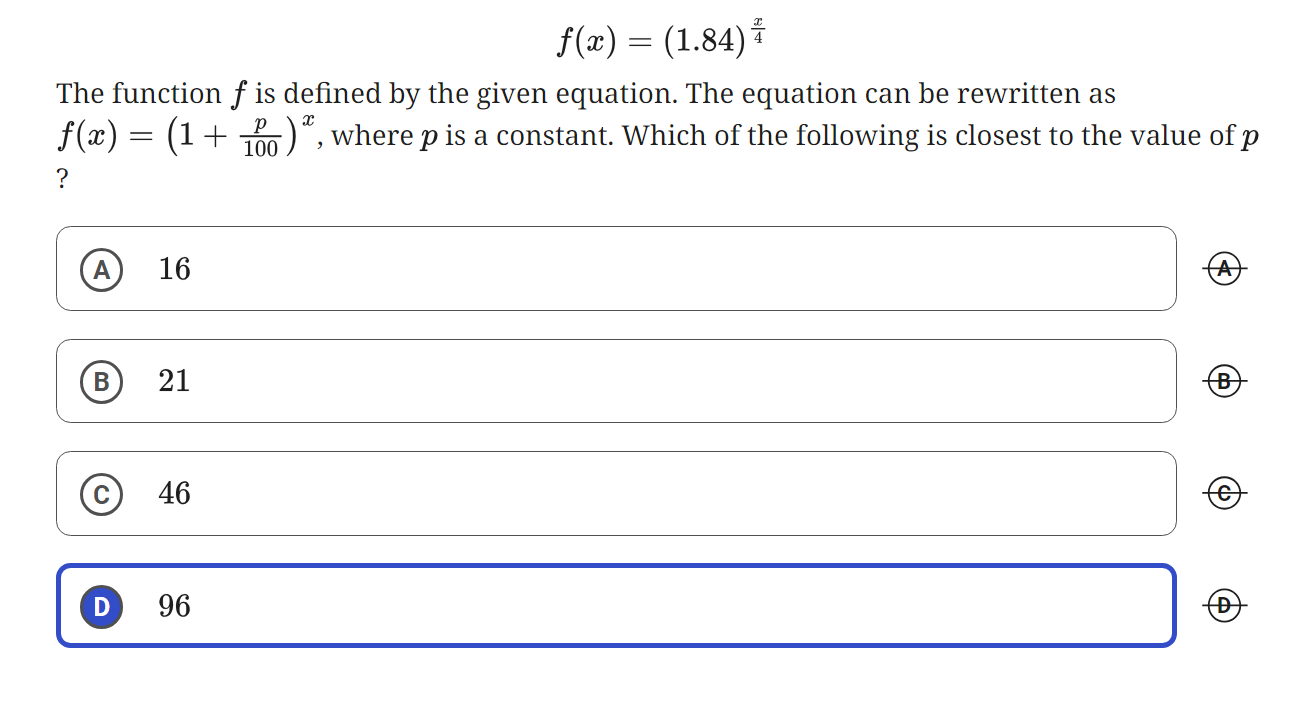The function f is defined by the given equation. The equation can be rewritten as f(x) = (1 + p/100)^x, where p is a constant. Which of the following is closest to the value of p?

Understand the Problem
The question is asking to rewrite the defined function in a different form and then determine the constant value 'p' based on given options.
Answer
21
Answer for screen readers
The value of $p$ is closest to 21.
Steps to Solve
-
Identify the given function forms
The equation is given in two forms:
$$ f(x) = (1.84)^{\frac{x}{4}} $$
and
$$ f(x) = \left(1 + \frac{p}{100}\right)^{x} $$ -
Rewrite the first function
To match the forms, we can express the exponential function: $$ (1.84)^{\frac{x}{4}} = \left((1.84)^{\frac{1}{4}}\right)^{x} $$
This means that the base is: $$ 1 + \frac{p}{100} = (1.84)^{\frac{1}{4}} $$ -
Calculate $(1.84)^{\frac{1}{4}}$
Now let's compute the value of $(1.84)^{\frac{1}{4}}$:
Using a calculator or computer, we find: $$ (1.84)^{\frac{1}{4}} \approx 1.1803 $$ -
Set up the equation for p
Now we can set up the equation as follows:
$$ 1 + \frac{p}{100} = 1.1803 $$ -
Solve for p
Subtract 1 from both sides: $$ \frac{p}{100} = 1.1803 - 1 = 0.1803 $$
Now multiply both sides by 100 to find p: $$ p = 0.1803 \times 100 \approx 18.03 $$ -
Identify the closest option
We check the options provided; the closest value to 18.03 is:
- 16
- 21
- 46
- 96
Therefore, the answer is 21 since it is the nearest to 18.03.
The value of $p$ is closest to 21.
More Information
The problem involves rewriting exponential functions and relates to continuous growth rates. Understanding how to transform equations between different forms is a critical mathematical skill, especially in calculus and growth modeling.
Tips
- Forgetting to convert the base correctly when rewriting exponential functions.
- Miscalculating $(1.84)^{\frac{1}{4}}$ which can lead to incorrect results for p.
- Rounding errors can lead to picking an incorrect option.
AI-generated content may contain errors. Please verify critical information